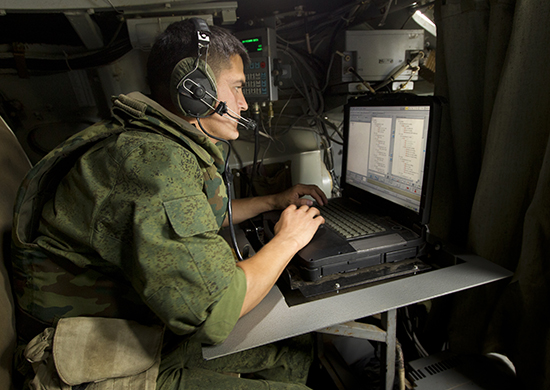
Moscow Promotes Military Communications Systems for 21st Century Conflict
Publication: Eurasia Daily Monitor Volume: 17 Issue: 31
By:

A critical feature in the transformation of Russia’s Armed Forces since the political leadership introduced the reform and modernization efforts in late 2008 has been the extent to which older analogue systems of military communications have been digitized. This complements wider efforts to adopt and integrate automated command and control (C2) as the force structure modernizes for the challenges of modern warfare. While many advances have been made in these areas, challenges persist. A recent commentary in Nezavisimoye Voyennoye Obozreniye contextualizes this drive to adopt modern communications and navigational systems by examining the levels of progress since the Russia-Georgia conflict of August 2008 (Nezavisimoye Voyennoye Obozreniye, February 28).
Colonel (ret.) Anatoliy Tsyganok, a member of the Academy of Military Sciences, writes about the experience and achievements in Moscow’s efforts to enhance communications within the context of modern approaches to C2. In addition to the important observations Tsyganok makes, the article is also significant in the fact that a Moscow-based defense specialist is analyzing some of the Russian military’s experiences derived from its involvement in the Ukraine conflict. However, Tsyganok’s starting point is to highlight the communications deficiencies the Russian military encountered during its operation in Georgia in 2008, some of which were exploited later by the political-military leadership to justify the need to reform the Armed Forces (Nezavisimoye Voyennoye Obozreniye, February 28).
Tsyganok notes that the conflict with Georgia was denoted by the near “complete lack of communication in the 41st, 42nd and 43rd battalions. In particular, in the 43rd Battalion, before noon on August 8, there was no information about what was being done in Tskhinvali and Gori. Due to poor logistical support and a lack of water flasks, the 42nd Motorized Infantry Battalion took refuge from the extreme heat (+40°C) in an oak grove, where it was bombed by Russian attack aircraft. There were 22 dead in the battalion, and many wounded were left in place.” He also notes some of the extreme communications issues that hampered operations conducted by the Airborne Troops (Vozdushno-Desantnye Voyska—VDV) in South Ossetia and in southern Georgia.
The cited article’s author asserts, “A serious miscalculation was the complete dependence of all weapons—aircraft, helicopters, ships, tanks, artillery, MLRS [multiple-launch rocket systems], high-precision munitions, cruise missiles—on navigation support. The Russian army needs to deploy its own satellite constellation, capable of providing troops with navigation data. There is a need to put in place a new navigation system for operational support, which is currently in its infancy” (Nezavisimoye Voyennoye Obozreniye, February 28).
By 2014, Moscow had made considerable advances in military communications, including digitizing much of the communications system. Tsyganok compares this to similar efforts in the Ukrainian Armed Forces, which were undermined by the lack of discipline in radio usage. The author explains, “Ukrainian units are equipped with digital mobile stations and leave mobile phones on the base, while commanders pay insufficient attention to the discipline of radio communications in the unit. Even the most secure radio communications, if used while driving, unmask the troops. Any broadcasting, especially in areas bordering the Russian Federation, was [detected], and the Russians launched artillery attacks on these places. To ensure surprise attacks during the redeployment of troops, it is advisable to stop radio communications with any correspondents until the signal is sent” (Nezavisimoye Voyennoye Obozreniye, February 28).
Tsyganok also argues that early in the Donbas conflict, the (Moscow-backed) separatist units suffered from severe communications issues, which hampered their performance. The author places the nature of the separatist communications weaknesses in relation to a lack of both advanced equipment and well-trained specialists. “The lack of specialists and communication instructors in the militia [separatist] units played a role. Some fighters were not able to master all the functions of radio stations, remaining only primitive users. Many civilian models did not match their performance characteristics. During a 270-kilometer march of an armored convoy, an accident involving infantry fighting vehicles occurred. The distance to the head marching patrol, where the eldest was, did not exceed ten kilometers, and it was not possible to use ‘Kenwood’ [radios],” which, in open areas, were only reliable at distances three times that (Nezavisimoye Voyennoye Obozreniye, February 28).
More recent events, such as the November 2018 seizure by Russia of Ukrainian vessels passing through the Kerch Strait, prompted Tsyganok to highlight an ongoing weakness within Russian military and security communications. He noted, “The first radio station, which not only caught up, but surpassed foreign models in some respects, was the R-187P1 Azart radio station, which relates to communication systems of the 6th generation. It can work in repeater mode, showing the commander the location of each subordinate. The radio station receives a signal from a satellite, a television signal, waves of all operational services. The radio provides data transfer at a speed of 7.5 kilobits per second; with its help you can call any mobile [phone].” Tsyganok additionally analyzes communications between the Federal Security Service (FSB) and the defense ministry, which was important during the Kerch Strait incident because Russia’s border service functions as a part of the FSB: “That is, only generals of these departments can call each other, and commanders of border guard patrols are forced to communicate with their colleagues from the navy through open communication” (Nezavisimoye Voyennoye Obozreniye, February 28).
According to Russia’s defense ministry, considerable progress has been made in introducing advanced C2 and the supporting communications infrastructure, though they have struggled to integrate automated C2 (Tvzvezda.ru, December 26, 2019; Topwar.ru, June 5, 2019). Tysganok’s commentary on many of these developments since 2008 offers context and insight into the levels of progress and some of the weaknesses and challenges that remain within the Russian military.



